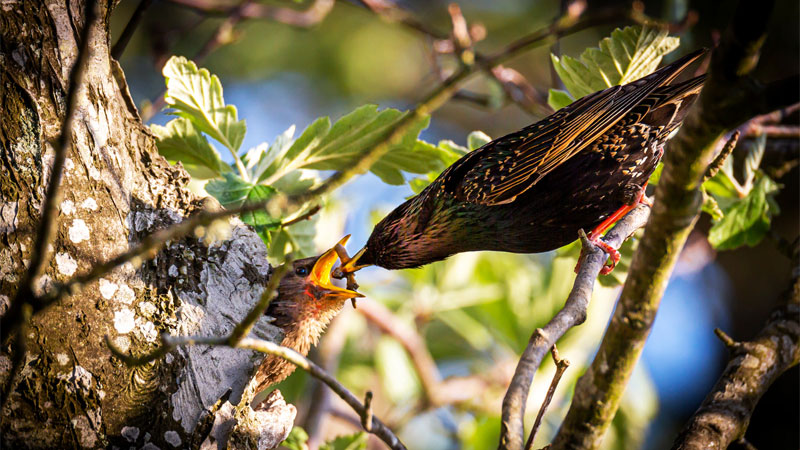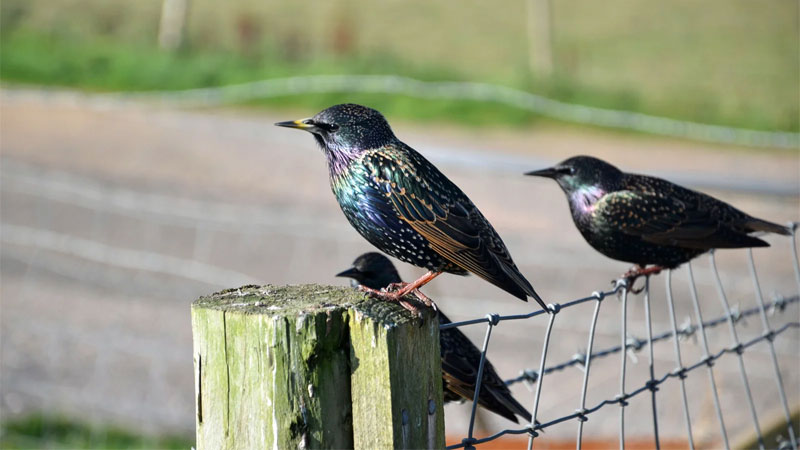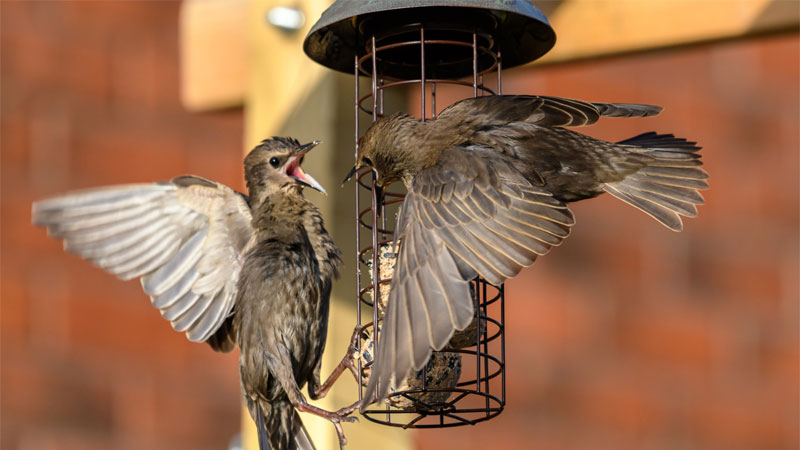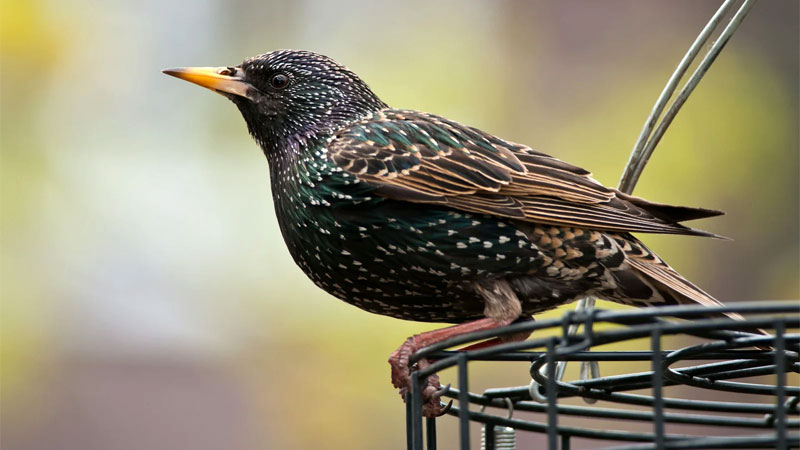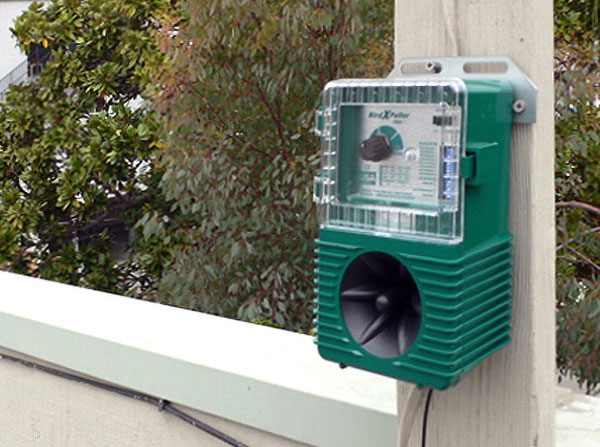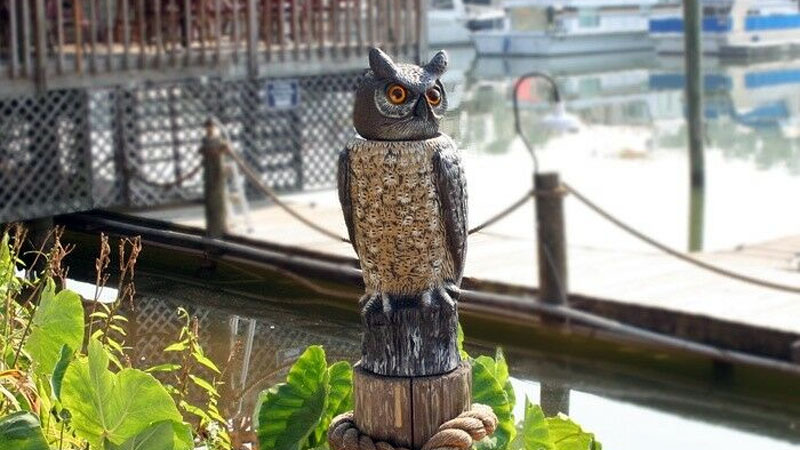Birds are some of the most beautiful critters, but not everyone loves them. Some birds are incredibly beneficial, while others are total nightmares. One excellent example of the latter is the European starling, better known as the common starling.
Starling is the name given to the Sturnidae family of birds, many of which have become invasive throughout much of the world. The most widespread is the common starling, which has several subspecies of its own. But when it comes to the US, it’s the main species that’s become a major problem.
Let’s take a few moments to look at the common starling, why it’s such a problem, and various ways to get rid of starlings when they invade.
Getting to Know Starlings
There are a few species of starling that have made their way to the US. However, only the common starling (Sturnus vulgaris) are considered almost universally to be pest birds. These birds are highly adaptable, highly prolific, and serious troublemakers.
Identifying Starlings
The common starling (AKA European starling) are around eight inches long with glossy, metallic plumage. Their legs tend to have a pinkish hue, but they also have some seasonal variations. For example, their yellow beak turns black in winter, and their feathers will develop white species at various points of the year.
On the ground, starlings will walk or run, and in the air, their triangular wings beat rapidly and are capable of short glides without losing altitude. They can achieve speeds of 50 miles per hour and can travel as far as 930 miles before needing to land.
Where Do Starlings Come From?
Starlings originated in Africa, Asia, and Europe. The African species tend to be quite colorful, which contributed to bird aficionados seeking them out. Many were kept as pets, only for them to escape and establish themselves in their new environs.
The story of how common starlings invaded the US is something of a poetic tragedy, however. The American Acclimation Society attempted to introduce the birds into Cincinnati, New York City, and Quebec during the 1870s. However, all three attempts failed.
In 1890, the society’s president, Eugene Schieffelin, released approximately 60 starlings into Central Park. Legend has it, he was attempting to bring culture to the city by introducing every bird that was named in the works of Shakespeare (although there’s no evidence to support this theory).
Another 25 mating pairs were released by the Portland Song Bird Club on the other side of the country at nearly the same time. In both cases, the starlings not only survived, but began to thrive.
Similar to how they adapted in Australia (where they were introduced to help control crop pests), the common starling quickly adapted to life around humans and grew in both population and range, becoming a national sight by 1940. Today, there are estimated to be more than two million in the US alone.
The Starling Lifestyle
Starlings have adapted to life in North America by adopting two different habits. Those in the US tend to spend most of the year in the same general areas. However, those that have made their home in Canada will migrate south into the US during the winter.
In both cases, they prefer to travel in highly coordinated flocks which can take off, land, and perform aerial maneuvers in almost perfect harmony.
When left to their own, starlings are capable of forming roosts with as many as 1.5 million birds. The males build nests in almost any suitable cavity. These are adorned with flowers and greenery to show a female they’re available.
Once a female accepts the male as a mate, she removes the decorations to signify “this nest is taken”. They will then continue to build up the nest after mating. The male will tend to sing merrily during this entire period.
The size of the flock and how close together nests are built can have a significant effect on the birds’ sexuality. In situations where there are multiple nests, a male may mate with a second female, and sometimes a pair will bring in a third to help with the nest.
However, when left to their own, the starlings will remain monogamous, and studies of this behavior indicate that a secondary partner has a much lower success rate with reproducing.
The Life Cycle
Mating season is spring and summer, with a fertilized female laying one egg per day with four to five eggs in the average clutch. If an egg is lost, the female will often lay a new egg to replace it. The eggs are usually a glossy pale blue (although white eggs are known to occur) to make them easier to spot in low light.
The male helps with tending the nest during the day but will often abandon the female at night for the communal nest. It takes approximately 13 days for the eggs to hatch and the chicks are naked and vulnerable for a week, with sight coming in by the ninth day. At this point, the parents will usually stop removing droppings from the nest.
They remain nestlings (i.e. nest-bound) for three weeks and usually spend another two weeks in the fledgling (learning to fly) stage. After two months, the chicks have their first molt, granting them their initial plumage (adult plumage happens the following year).
Nests are reused, with two to three broods each year, and the parents tend to keep the nest clean and ready for use.
European starlings tend to live two to three years in the wild, but have been known to live up to just shy of 23 years under ideal conditions.
What do Starlings Eat?
Starlings are primarily insectivores, which was the reason they were introduced to many parts of the world. This includes a wide range of insects and arachnids. However, they’re also known to eat amphibians, lizards, snails, and worms. This diet provides all the nutrients necessary for successful reproduction.
But, like many critters commonly referred to as insectivores, starlings are technically omnivorous. They’ll go after fruit, grain, nectar, seeds (especially shelled sunflower kernels), and discarded human food. When it comes to fruits, cherries and grapes are a favorite, but the starlings have trouble digesting any fruits high in sucrose.
Common starlings also have three methods of getting their food. They might lunge at morsels on the ground, catch bugs in midair, or probe the ground with their beak, opening the mouth to widen holes. This last method can be frustrating because they’ve learned to use this technique to get access to trash bag contents.
Starlings vs Humans
While European starlings have never been the most popular birds out there, their reputation as insectivores has led to more frustration than benefit for many farmers. Here are just some of the ways in which these birds interact with people.
Clogs
Starlings will build their nest in just about any sufficient cavity, including gutters or even in your attic. This can lead to clogs and eventually leaks or structural damage to your home.
Even worse, they have no issue building a nest in a chimney or exhaust vent for extra warmth and will nest inside ductwork if given access. This can drastically reduce indoor air quality and may even result in fires.
Disease
The nests and droppings of a starling can contain a variety of pathogens, such as E.coli, fungi, parasites, and bird mites.
Droppings
Much like geese, starling poop can quickly turn your yard into a Slip ’N Slide. The droppings are also highly acidic, which can mess with soil quality, damage car paint, cause staining to decks, degrade masonry, and usually appears in abundance due to how many starlings tend to flock together at any given time.
In some cases, the amount of poop is so extensive that professional cleaning is required.
Starlings vs the Environment
Beyond issues to human structures and general health and safety risks, these birds also create environmental issues.
Competition
Perhaps one of the greatest concerns is that European starlings are highly adaptable, making them capable of out-competing native birds. Even worse, they sometimes prey on native wildlife. As a result, several species have become endangered where starlings gather.
Lawn and Garden
Starlings can tear holes throughout your lawn in search of food (not to mention the aforementioned poop issue). They’ll ravage plants that have gone to seed, munch on seedlings, and are known to destroy vegetable gardens.
They’re especially brutal against grain crops, vineyards, and cherry orchards. This behavior results in huge agricultural losses each year.
Sound Pollution
Starlings aren’t the quietest of birds. In fact, they seem to do everything at the top of their lungs.
Picture a tomcat serenading at 3 AM and you have an idea at the volume. Now imagine a chorus dozens or even hundreds of starlings having a midnight polka party in your backyard without inviting you. Nothing else needs to be said on this issue.
Starlings vs Grackles
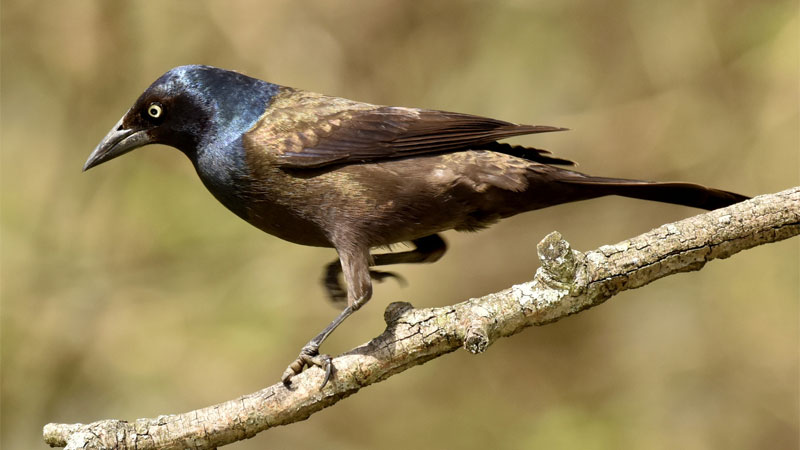
Grackles have a similar appearance to the European starling, but there are several significant differences (not the least of which is their different ancestries).
There are ten species of grackle, and they tends to measure a foot long, which is 1 ½ times as big as the starling. Common grackles are mainly black, but their heads are a dark, iridescent purple.
Compare this to starlings, which are speckled in much of the year and tend to have a greenish-purple tint when the light hits their feathers during summer months. Grackles are also not known to inhabit the western portion of the US.
A lot of the confusion between these two species actually comes from several species of starling that aren’t found in the US but have been given nicknames containing the word grackle.
Getting Rid of Starlings
Whether you live on a farm or in the city, starlings can be a huge problem. The good news is that it’s possible to get rid of them and keep them from coming back, although it may take a little work.
Here’s what you need to know to make your life a little less crazy.
The Great Kill Debate
First and foremost, we should address a few common questions regarding kill methods. The biggest concern is whether it’s legal at all, and this will vary from one region to another.
In some places, they’re considered a protected species under the Migratory Bird Treaty Act. In others, it’s open season on this invasive species.
That said, be sure to check for any local or state regulations before attempting any kill method.
Can You Poison Starlings?
When poisoning any bird species, you have to be careful not to also poison other birds in the process. This tends to rule out a wide range of chemical products, but there’s one good choice out there: Starlicide.
Starlicide (or DRC 1339) is highly toxic to European starlings and gulls, but far less toxic to humans, as well as most animals and birds. The poison isn’t instantaneous, so a starling may travel some distance before dying.
This has caused mass panic in at least two instances where the USDA were culling starling populations and birds were literally dying in midair with puzzled humans running for cover below and wondering if it was the apocalypse (or Hitchcock’s revenge).
Can You Shoot Starlings?
There’s no easy answer to this, and the rules vary greatly. Some states (Pennsylvania, for example) have declared there’s no closed season or restriction for shooting the European starling.
Other states have specific hunting seasons or restrictions on where you can hunt starlings. And others still require a special permit or ban the practice completely.
Non-Kill Methods
There are several non-kill methods to help you get rid of a starling problem, many of which double as preventative measures. Here are some options for when they’re already here.
Electronic Bird Repeller
Some have had good success with electronic devices. This product emits natural bird sounds and predator calls to scare away starlings, pigeons, sparrows, and other problem birds. With optimal placement, it can provide up to 1 acre of coverage.
- The ultrasonic sounds and flashing LED strobes eliminates all animal intruders...
- Features three ultrasonic frequency settings, 7 sensitivity settings plus an...
- Attach the included stake to the repeller and stick it into the ground then...
Curtains and Netting
If you find a starling nest in your attic or barn, take it apart and hide the nesting materials so they can’t rebuild. In an attic, you will need to find the access point and seal it, but in a barn, that can be a little more difficult.
Barns and other areas with entrances that tend to remain open can be protected using bird netting or plastic strips. The latter is especially useful for barn entrances.
Simply get some heavy plastic strips and attach them vertically to the door frame on the inside. This will stop any birds from flying in while humans and livestock can get in and out unimpeded.
It can be a little more difficult if you have chickens, as you can’t simply remove the nesting material. Instead, build an enclosure for your chickens using a heavy gauge wire. Not only will this prevent the starlings from getting in, it can also help deter other predators such as coyotes, foxes, or stray dogs.
Call for Help
Starlings may be highly adaptable, but that doesn’t mean they don’t have natural predators. If your city employs them (or you happen to have some in your area), consider inviting larger predator species such as hawks or owls.
These will help chase the starlings away, although they may also attack wanted bird species or even small pets, so use this option with caution.
Of course, if you have more than a single mating pair, it might be best to call in the big guns. Wildlife authorities and many pest control companies are trained to handle starlings.
Starling Traps
There are bird traps available that, when baited, will catch starlings or other birds and allow you to relocate them. While these are humane and effective, they’re only a good option in a pinch and won’t prevent the birds from returning once released.
Preventing Starling Visits
Many of the methods for repelling starlings are similar to those used against crows. You might already be familiar with some of these methods.
Access Points
Begin by adding screens or sealing any potential access point (such as holes in the roof or exposed vents) on the exterior of your home and any other structures. For gardens, consider enclosing them in a wire frame so birds can’t fly in – but bees and butterflies can. Use bird spikes, gutter covers, and reflective tape to make your home and property less hospitable.
Starling-Proof Bird Feeders
Having bird feeders, suet cages, or water sources such as bird baths can attract starlings. Consider investing in an upside-down suet feeder to make feeding more difficult.
You can also consider enclosing your bird feeders in cages that allow small species in. Just be warned this can also prevent larger birds cardinals, blue jays, and other large species of birds from having access.
Alternatively, try using foods that starlings don’t like, such as nuts (in their shells), safflower seed, and sunflower seed. These all have casings that are too tough for a starling’s softer beak to crack open.
Don’t forget to remove any sources of standing water where possible and limiting access to natural water features.
Bird Boxes
Another way to deter starlings is to ensure any bird houses or other manmade bird shelters have an entrance the starlings can’t fit into. Be sure to prune any trees so there are fewer nesting spots available to the starlings.
Audiovisual Repellents
Giving a performance can be another great option. Motion-activated sprinklers, sound devices, predator kites (as in birds, not xenomorph hunters), decoys, and scarecrows can all be effective. Remember, you’ll need to move these tools around every few days or the starling will figure out they’re not real.
- How to Get Rid of Hawks - March 8, 2024
- How to Get Rid of Pill Bugs (Rolly Pollies) - March 1, 2024
- How to Get Rid of Groundhogs (Woodchucks) - February 5, 2024

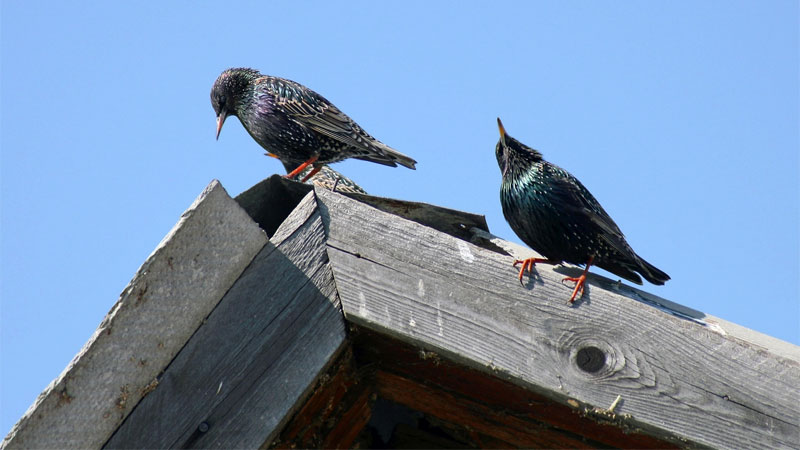
 Just tell me how to get rid of ’em.
Just tell me how to get rid of ’em.
